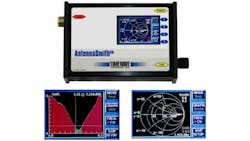Conventional wisdom (and your neighborhood venture capitalist) says you can't go to market with a new product until you have a business plan, a second mortgage, an offshore manufacturing contract, and sales projections that guarantee 20% return on investment (for the VC).
But here's a wireless product that an engineer with a day job worked up on his home workbench in his spare time. He then productized and released it to a domestic manufacturer that markets it through a small number or specialized retail sales channels. It didn't make him a millionaire, but he accomplished what most of us would love to do at least once in our careers.
Dale O'Harra's AntennaSmith antenna impedance analyzer measures the scattering parameters, across a frequency range of 200 kHz to 55 MHz, of whatever a user hangs across its RF connector (see the figure). It then displays log plots of voltage standing-wave ratio (VSWR), impedance, and reactance, along with Cartesian plots of reflection coefficient phase and amplitude or a Smith chart.
I asked O'Harra about envisioning a product and bringing it to market without the fuss of business plans, venture capitalists, offshore manufacturing, and endless meetings. He explained that a combination of serendipity and a limited market made it possible.
The key chips in the design are a Silicon Laboratories 8051-based controller and an Analog Devices AD9851 direct digital synthesizer (DDS). The controller provided a built-in eight-input multiplexer feeding a programmable gain amplifier ahead of a 12-bit analog-to-digital converter (ADC) running at 12 kbits/s, all of which provided effectively 19 bits of dynamic range.
Additionally, the Silicon Labs controller provided the USB port that enables the AntennaSmith to talk to PCs. The DDS saved the trouble of designing a phase-locked loop and allowed frequency resolution to 1 Hz. Forward and reflected power are measured using a simple bridge. A secondary input on the box permits swept insertion-loss measurements.
The display, a key part of the design, shows the advantage of the limited market. O'Harra purchases the displays from a company called ezLCD that buys up surplus Sony displays and mates them with its own Atmel controllers to provide a fast GUI solution. The display supply isn't infinite, but it should be enough for several years of production.
Software development was straightforward, given the wealth of tools available for the 8051. O'Harra says the only tricky part was computing the correct sign for the phase of the reflection coefficient, for which he developed a recursive algorithm.
The circuit board was laid out using CadSoft Online's relatively inexpensive Eagle editor. It's manufactured from the Eagle Gerber files by PCB FAB Express in Sunnyvale, Calif. The ability to use a local custom-board house is another advantage of small volumes.
O'Harra hand-soldered the surface-mount components on his prototypes. He has a steady hand and acute myopia—a blessing when lining up a 100-pin quad flat pack on its solder pads. O'Harra says the trick is to nail down two opposite corners first. The case is an aluminum extrusion with custom plastic ends.
"Serendipity" particularly describes the process by which AntennaSmith evolved from a mere project to a retail product. Silicon Valley has an active amateur radio community. During one monthly get-together at the Stanford Linear Accelerator Center, O'Harra met a ham from Timewave Technology of St. Paul, Minn. They talked. A lawyer friend loaned O'Harra a book on licensing agreements. A short time later, a contract was signed, and Timewave took over manufacturing and marketing.
Today, the AntennaSmith retails for about $1200 through amateur ratio suppliers. No one wore a necktie at any time from first concept to first sale.
Timewave Technology
www.timewave.com
ezLCD
www.ezlcd.com
Cadsoft Online
www.cadsoftusa.com
PCB FAB Express
www.pcbfabexpress.com
